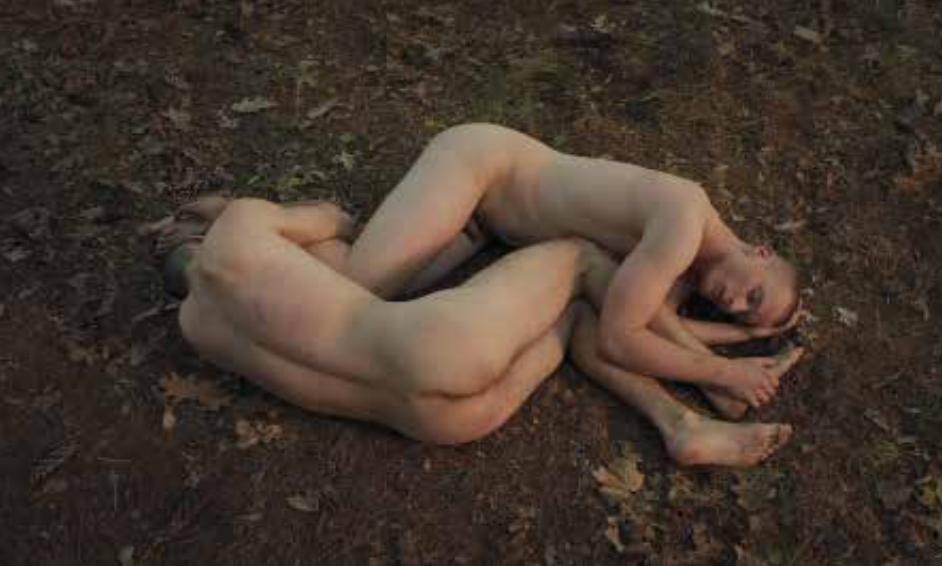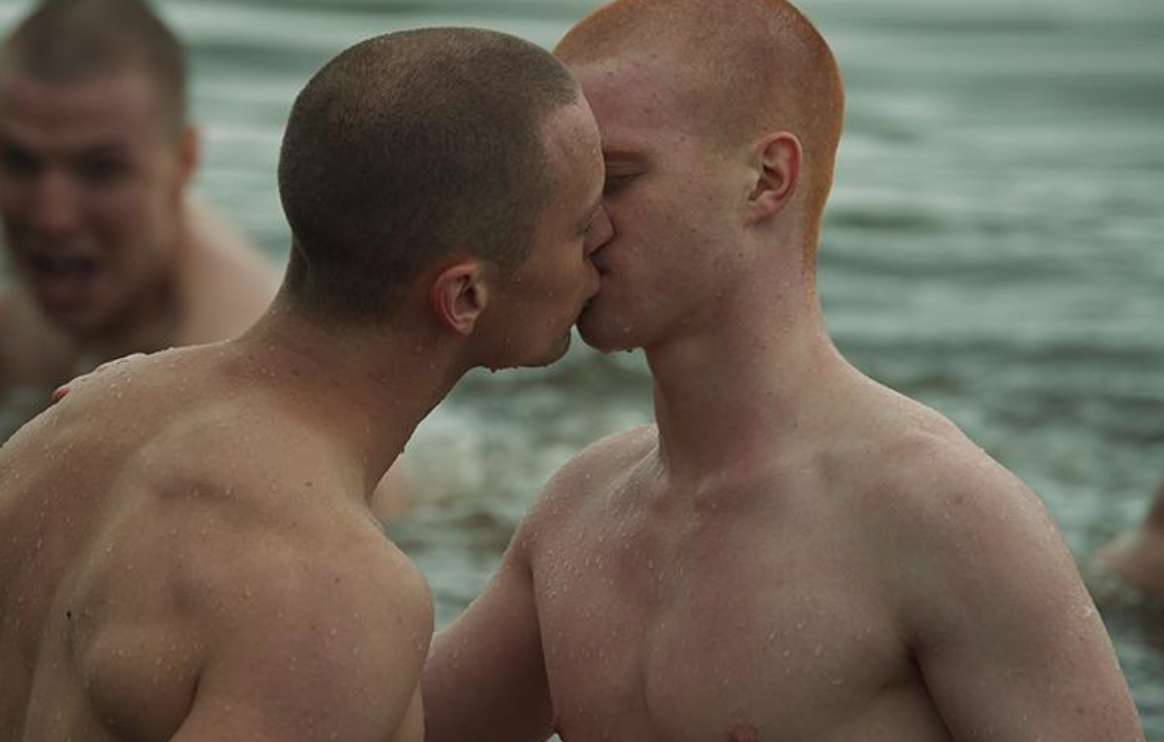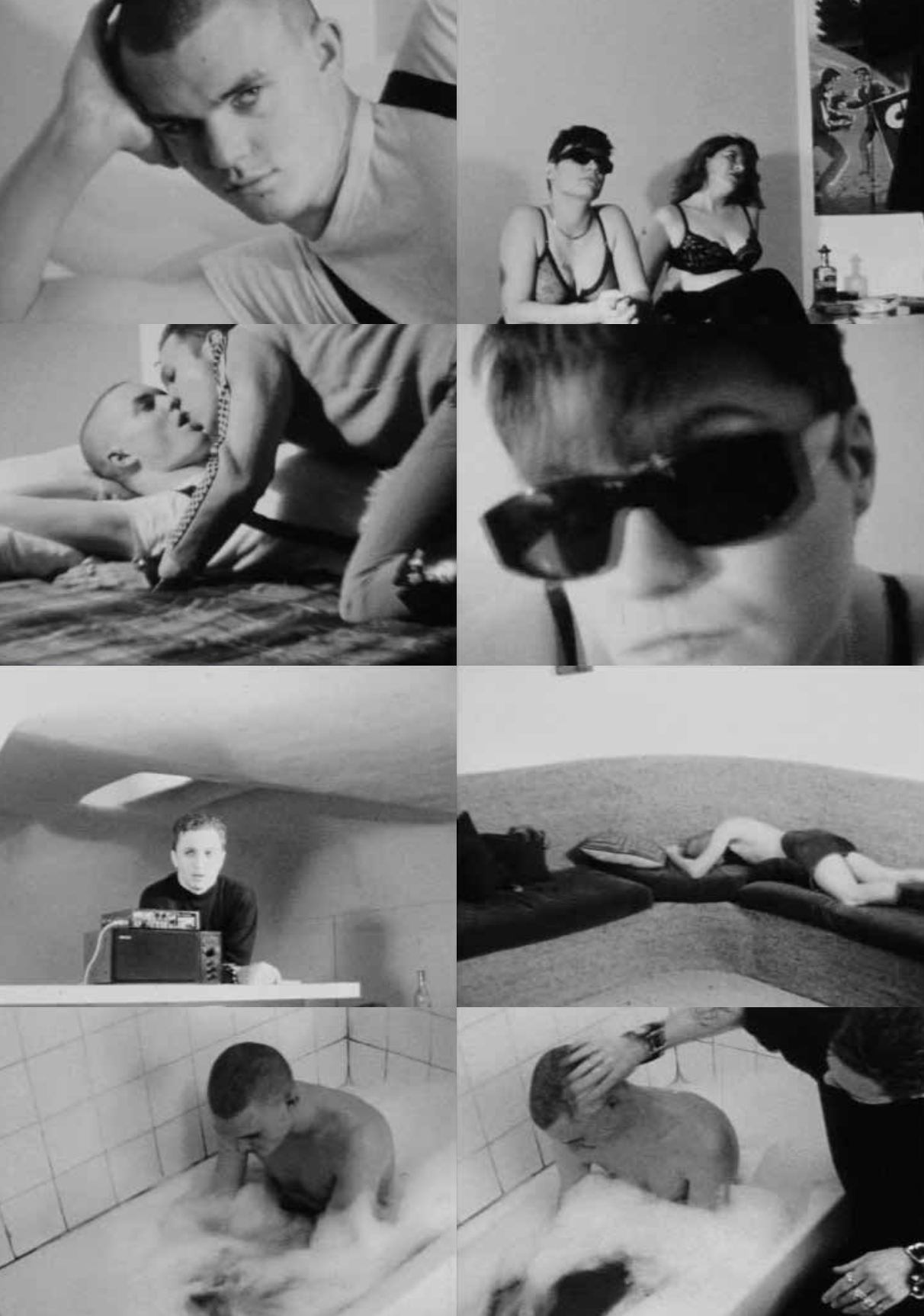BRUCE LABRUCE
Interview by Michael Bullock
Images courtesy of Bruce LaBruce
Frieze, 2021

Ahead of the release of his thirteenth feature film, Saint-Narcisse, cult filmmaker BRUCE LABRUCE speaks to writer Michael Bullock about porn, punk rock and the aesthetics of radicalism
Your work often explores queer subcultures and pornography as tools of political dissent. In your films, explicit queer sex is deployed as a means of empowerment and liberation. When did you begin to think about sex and sexuality that way?
In 1985, I started J.D.s, a queer-punk fanzine, with lesbian artist G.B. Jones. It was the era just after gay liberation, the engine of which was a very aggressive, militant sexuality. In Toronto, the leather bars were always packed, and there would be lines at the saunas even on weekdays. I was partly caught up in all that but also disillusioned with the mainstream gay movement because it was sexist, misogynistic, racist and classist. So I turned to punk. But punk was kind of homophobic and misogynistic as well, so my friends and I made our fanzines and Super-8 movies as queer and in-your-face as possible, to tell the punks that they weren’t as radical as they claimed to be if they couldn’t accept us. I collaged extreme images from the gay world that coincided with punk, like Mohawks and leather, alongside images of actual punks. The mosh pit was a big turn-on for me. I shot this amazing punk show in Toronto at the Silver Dollar Room during the 1988 Anarchist Unconvention, on Super 8, with a lot of hot, sweaty skinheads and punks with their hands all over each other. I then spliced it with footage from an old Super-8 Al Parker film, gave it a Carpenters’ soundtrack, using the songs ‘Superstar’ [1971] and ‘Hurting Each Other’ [1972], and called the film Slam! [1988]. It was designed to provoke the punks – to point out not only how homoerotic they were but also that their internalized homophobia was a repression of their own homosexual desires. The thing that distinguished J.D.s was its weird juxtaposition of a hardcore punk aesthetic with a romantic sensibility mixed with porn. Jones and I were also really into classic Hollywood films and Andy Warhol’s Factory. And we were very militant about solidarity between lesbians and gay men. We were collaborating with transgender people, and our covers were racially diverse, adamantly so.
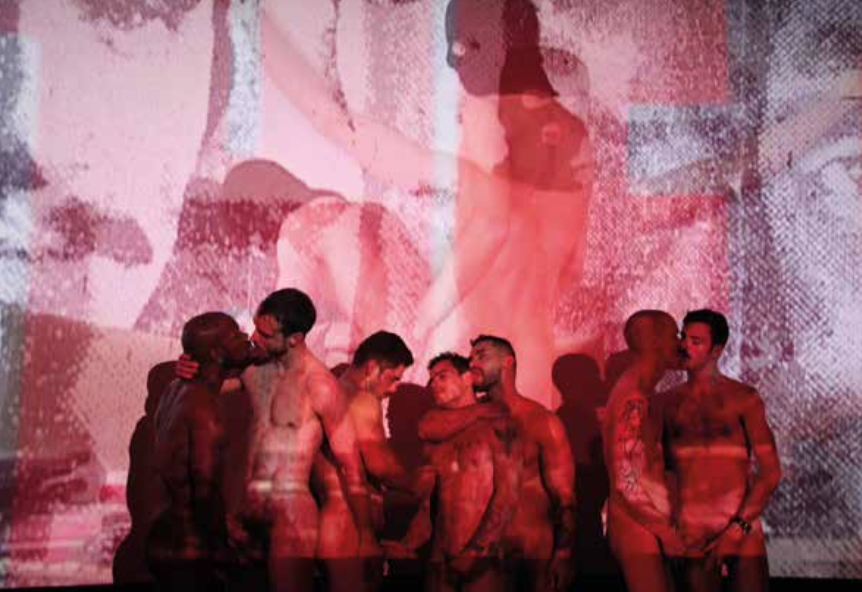
You’re sometimes thought of as a gay director, but you’ve always captured a broad spectrum of sexuality and fetish in your work.
I believe in Sigmund Freud’s notion of constitutional bisexuality: that everyone has bisexual potential [Three Essays on the Theory of Sexuality, 1905]. That makes me a really bad gay because you’re supposed to be ‘Born This Way’ [2011], a Lady Gaga fag, and I just don’t believe that. I believe in the mixture of nature and nurture and that heterosexuals have homosexual potential and vice versa. I always refer to myself as a repressed heterosexual. In 2018, I shot Scotch Egg and Valentin, Pierre & Catalina, shorts in which gay guys have sex with women, for Erika Lust’s XConfessions [2013–ongoing]. I consider them experimental films.
What does the wide availability of porn now mean for your audience’s sensitivity towards the sexual taboos in your work? With Scotch Egg, you seem to suggest that the last taboo for gay men is straight sex.
Whenever I say to myself, ‘Oh my god, I’ve gone too far,’ that’s when I know I’m on the right track. We used to joke that the kinkiest thing a gay man could do would be to fuck a woman. In one segment of my film Fleapit [2018], there’s one female character amongst about ten or 12 guys, and they’re all cruising each other in a movie theatre and having sex with each other in various permutations. CockyBoys, the production studio, got hate mail about it – from idiots who are so misogynistic that they can’t even see a woman’s breasts without losing their hard-ons. These days, there’s a new puritanism about sex that began as an unintended consequence of the #MeToo movement and has only gotten worse with COVID-19, since it’s treated almost like an STD. Sex is only validated if it’s considered equal, affectionate and monogamous. But sex isn’t a nurturing, walk-in-the-park type of activity. For me, it’s a dark-baroque, unruly-primal, aggressive drive. Freud believed that desire couldn’t exist without objectification, and that applies irrespective of gender. My new film, Saint-Narcisse [2020], explores self-objectification, which has become so rampant.
Do you say that because our society has become more dependent on Instagram and OnlyFans?
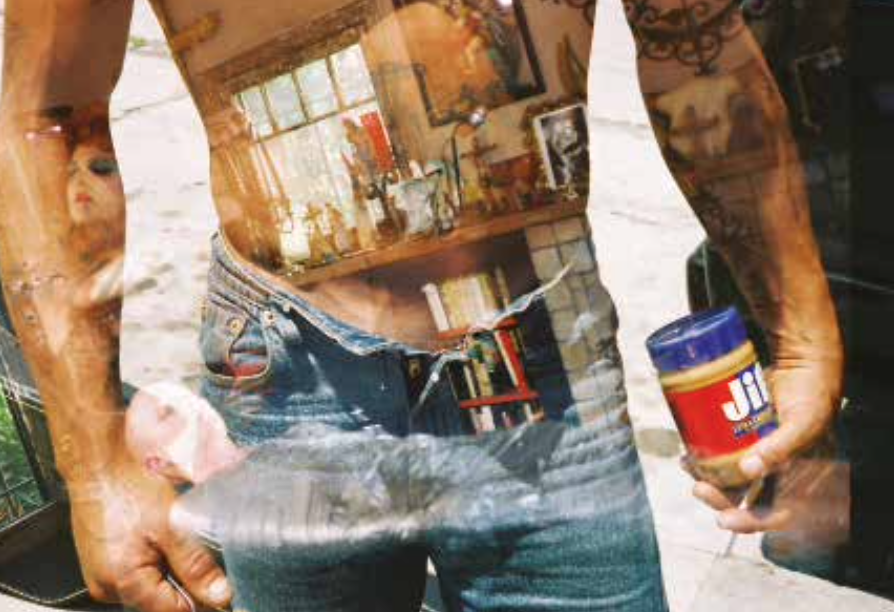
One thing that’s often missing from Instagays or performers on OnlyFans is a sense of self-deprecation or self-parody. A lot of performers are really fixated on their own sexuality to the point of mindless narcissism. I performed sex in my first two feature films and it was totally awkward. It was embarrassing for me back then to show myself to audiences, warts and all, so to speak. I’m very self-conscious in these films and I make fun of myself. But the awkwardness is more realistic and honest, and that can be sexy too.
In 2019, I edited Peter Berlin: Icon, Artist, Photosexual. Berlin, the gay erotic icon, was the first known ‘photosexual’ in the 1970s: a person who doesn’t desire the physical act of sex but finds sexual satisfaction in being looked at. Technology has allowed Berlin’s sexuality to permeate our culture.
In the 1980s, when I was in San Francisco, I did a long, two-part interview with Berlin for J.D.s. I first saw him in a Walgreens buying headache pills, and he looked like a poster of himself, fully decked out with his tight leather pants and big basket and high motorcycle boots. I lay on his bed in his apartment and asked him questions for a couple of hours. The apartment was crammed with photographs of himself. There were no images of anyone else in the entire place. Sometimes, extreme narcissism is justified: Berlin was so immaculate and embodied an ideal of gay sexuality at the time. It became his trademark.
In Saint-Narcisse, is the narcissistic fetish of Dominic, the main character, justified because he finds his twin brother Daniel [both played by Félix-Antoine Duval], his other half?
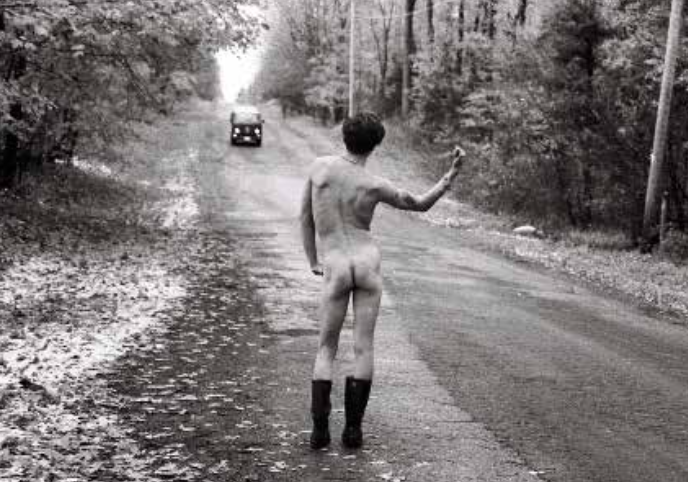
The twins complete each other. The tagline of the film is ‘Love Thyself ’, which is a kind of healthy narcissism. A lot of people – gay teens especially – have self-loathing because of their sexuality, so self-love can be really constructive for them. It’s left open to interpretation, but the sexuality of both twins is very fluid. Not only do they have sex with each other but Daniel, the twin that’s been raised in a monastery, has been in a full-blown gay relationship with the evil Father Andrew [Andreas Apergis]. He’s never known anything else; he’s only ever been in the company of men. But it’s implied that both twins are bisexual.
The film sets up a dichotomy between a healthy narcissism – the brothers’ love for each other – and a dark, sadistic variety, in the priest’s abusive relationship with Daniel.
The twins’ mother, Beatrice [Tania Kontoyanni], is narcissistic as well because she acts on her desires very selfishly, without really acknowledging what effect it has on the people around her. It’s implied that she has an intimate sexual relationship with Irene [Alexandra Petrachuk], her dead lover’s daughter, who resembles her mother exactly. In fact, the whole film is based on Freud’s idea of family romance: that there are inevitable sexual tensions within a nuclear family discouraged by social taboos. In the film, one family is matriarchal – Beatrice is the earth mother associated with nature and sorcery, who smokes pot and embodies the spirit of free love – while the other, represented by Father Andrew and the church, is ordered and civilized, but patriarchal. Beatrice is a much more sympathetic character because she was ostracized for being a lesbian. She is a victim of that patriarchal system – the church, marriage, monogamy – but both she and Father Andrew display aspects of what we might call toxic narcissism.
The historian Jonathan David Katz, in his essay for Peter Berlin: Icon, Artist, Photosexual, writes: ‘In the 1970s, when gay men finally embodied their own fantasies, they didn’t stay home and jerk off, but rather sought out other men whose desires resonated with them. Ovid got it wrong. Narcissism leads one outside oneself towards another. It’s only when we desire ourselves that we can desire one another.’ Is that connection between narcissism and gay empowerment one reason why you set the film in the 1970s?
I chose the 1970s partly to make the characters’ narcissism stand out in stark relief from the default narcissistic sensibility of our world today. When Irene finds Dominic’s Polaroids and says, ‘He only takes pictures of himself. I mean, who does that?’, everyone watching the movie will probably think, ‘My god, everyone does that now.’ Back then, it would have been considered obsessive and self-indulgent, which it is. The 1970s were also the period of the sexual revolution, which extended to the suburbs with swinger culture. I wanted to reference the time when polyamory was being explored in an almost mainstream way. It’s my favourite period of cinema, because filmmakers like John Cassavetes, Arthur Penn, Frank Perry, Jerry Schatzberg and Paul Schrader challenged the conventions of classic Hollywood and deconstructed the myths of the dominant order. In Quebec, at that time, there were filmmakers like Paul Almond, who completed a trilogy of works with his then- wife Geneviève Bujold, which is very dark but connected to nature and quite often about subjects like incest, family secrets and primitive sexuality. I saw Almond’s The Act of the Heart [1970] on Canadian television when I was 12 or 13. It stars Donald Sutherland as a priest who has sex with a young girl from rural Quebec, played by Bujold, on the altar of a Catholic church. Then she goes to a park, pours gasoline over herself and sets herself on fire, as the credits roll. That’s how the film ends. It really blew my mind. I felt the same way about Robert Altman’s That Cold Day in the Park [1969], which I saw as a kid on CBC. I later remade it as No Skin Off My Ass [1991].
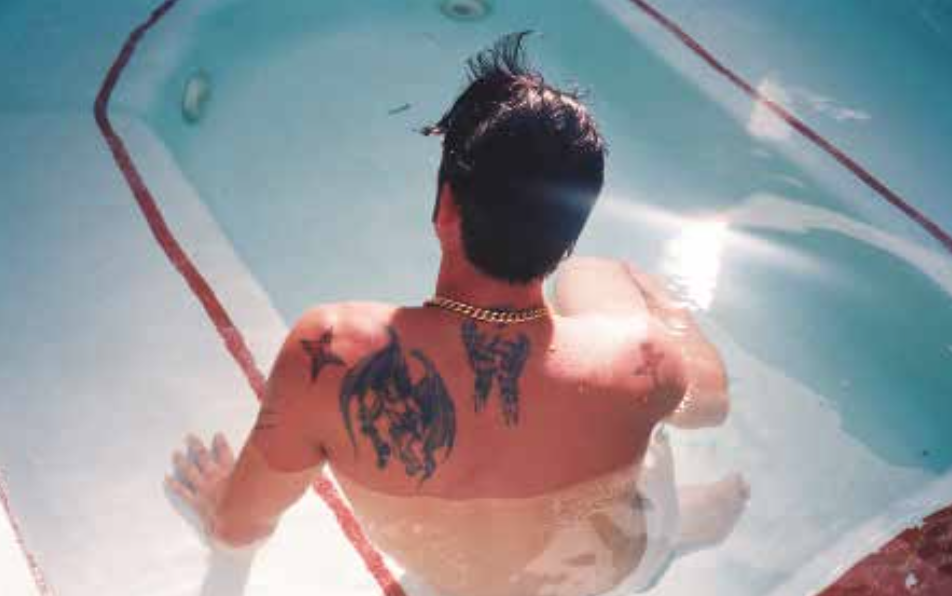
No Skin Off My Ass is a remake of an Altman film?
When I saw That Cold Day in the Park, I remember wondering if that’s what pornography is. It’s about a woman who keeps a young hustler locked in her guest bedroom as a would-be sex slave. It’s based on a novel by Richard Miles, who was gay. His version is set in Paris and is very camp. Altman de-queered it, so I decided to re-queer it. I play a punk gay hairdresser who lives in Toronto and locks a skinhead in his guest bedroom. When I showed the film for the first time in Los Angeles in 1991, somebody brought Miles to my screening and he said my no-budget Super-8 movie was better than the Altman version! He gave me an autographed copy of his novel inscribed: ‘You got it right!’ One thing I’ve tried to do in my work is to make fetish romantic. I see pure fetishists as martyrs to their objects of desire. It’s really a spiritual fixation: they have a great reverence for the love object.
You’re one of the only directors who has fearlessly put explicit gay sex into narratives. Straight people often see their sex lives depicted in narrative film, whereas gay people are used to only seeing their sex lives in pornography, detached from context, politics and emotion.
What I consider my political use of pornography pushes back against the liberal tolerance of homosexuality so prevalent today. They’ll put up with you as long as you’re well-behaved. Straight liberals don’t want to see gay sex. It’s that old, patronizing attitude: ‘I don’t care what you do as long as you keep it to yourself.’ All pornographers are artists; a lot of them are bad artists, but they’re still filmmakers and artists nonetheless. I’m tired of people looking down their noses at those who appear in or make pornography, even though they watch pornography themselves. That’s why I continue to make pornography and put gay sex in my films. You can’t view it from a safe, liberal distance. You have to just bend over and take it.
In The Misandrists [2017], the protagonist Big Mother [Susanne Sachsse] explains that ‘pornography is an act of insurrection against the dominant order: it expresses a principle inherently hostile to the regulations of society and, when men are taken out of the equation, there’s nothing more potent.’ When I heard that, it felt like you were speaking directly about what you do.
Absolutely. I identify so much with the female characters in my movies, like Medea in Otto [2008] or Gudrun in The Raspberry Reich [2004]. I identify with their politics. But I also affectionately critique the left and parody people who paint themselves into corners of contradiction – especially people who don’t practise what they preach. I half-jokingly call the extreme left’s policing of desire and language a Stalinist tradition. It’s paradoxical. It’s pro-censorship. But I’m still romantic for revolutionaries. I think the aesthetics of radicalism are so important. Punk wasn’t an articulated ideology; it was a style – quite often incorporating signifiers that completely contradicted one another, were illegible to most people or brought up more questions than they did answers. That’s crucial to my work.
In revisiting your films, I was struck by their many similarities to the Blaxploitation movies of the 1970s – some of the first mainstream films that made Black people their heroes and subjects – and I started to think of your work as a kind of gaysploitation.
In Super 81⁄2 [1994], my character says: ‘There’s Blaxploitation, sexploitation, this is Bruceploitation.’ I actually put out a monograph of photographs called Bruce(X)ploitation in 2012. I’m really into B-movies, another part of the underground that doesn’t exist anymore – John Carpenter, Larry Cohen, Wes Craven, Tobe Hooper, George Miller, George Romero, Stephanie Rothman – the pre-digital horror directors. My mentor and thesis supervisor at university, the late critic Robin Wood, interpreted their films in terms of sexual repression erupting in monstrous form. There were three concurrent revolutionary movements in the 1970s: the Black power movement, the women’s liberation movement and the gay liberation movement. They were all Marxist-based, and they all recognized exploitation entertainment and agit-prop as a means to connect with the average person. Blaxploitation was very camp in its way, and the gay lib movement expressed itself through camp, a kind of hidden language. Films of that era often had subversive messages that were an expression against the mainstream, against the Vietnam War and all forms of imperialism, against capitalism and against narrative and formal film conventions. That’s where my heart is.
